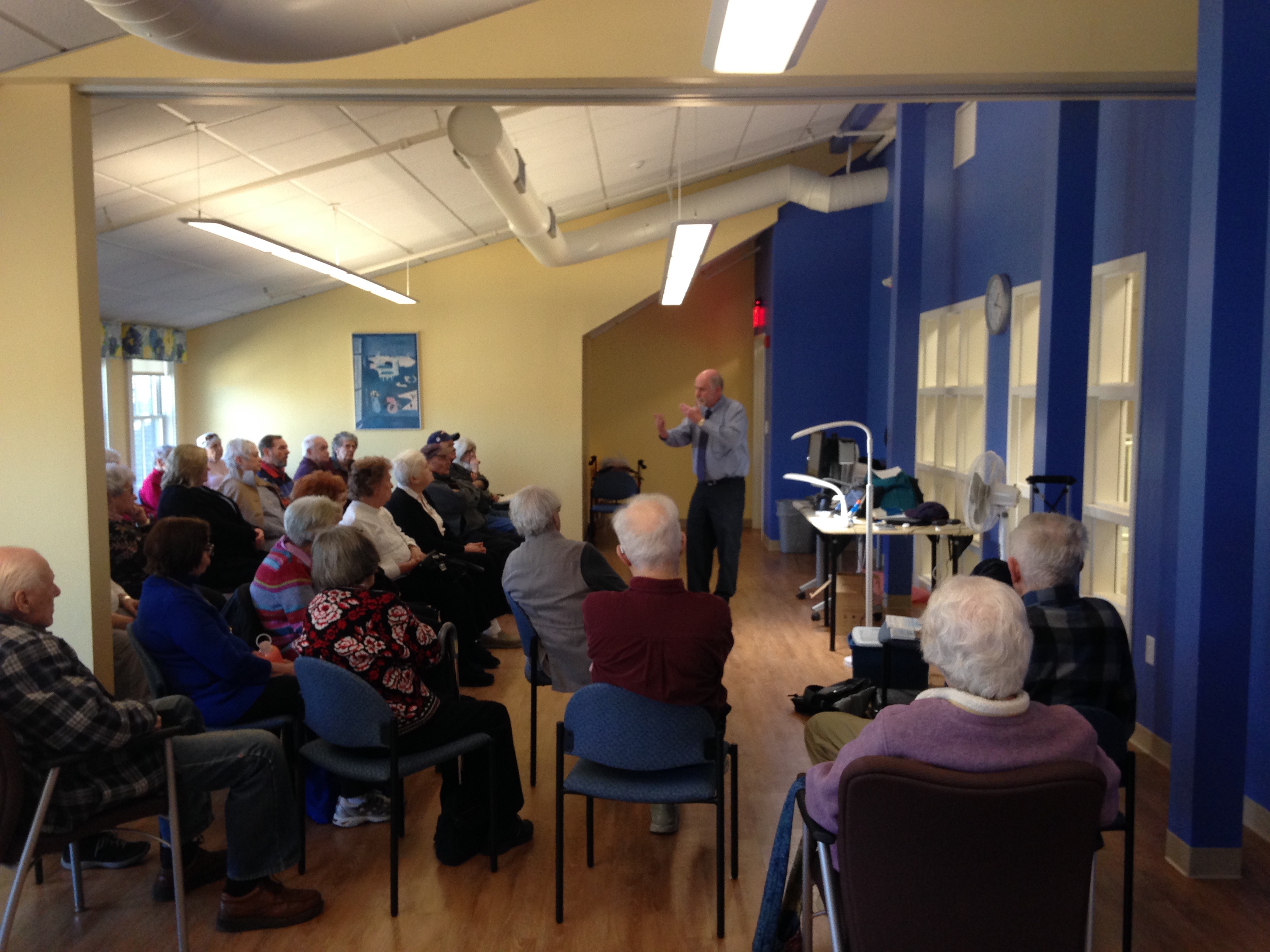“It’s hard to adapt to losing one’s senses. Those are major components. It’s ‘what do I do now?’” says Kathy Kubit, of Norfolk who lost her vision at age 56. “When I saw CCTV (Closed Circuit TV with a high-powered magnifier) and was able to see my hand, my world opened up again. I could live my life again. I thank God for all this stuff.”
The “stuff” Kubit refers to is the Assistive Technology available to people who have experienced various levels of vision loss. Kubit is a volunteer at one of just three vision technology centers in the state funded by the Massachusetts Councils on Aging and the Executive Office of Elder Affairs. The Stella Jeon Assistive Technology Center, or “Low Vision Center,” to which it is casually referred, is located at the Franklin Senior Center, 10 Daniel McCahill St., Franklin.
“We’re not limited to the towns – Franklin, Bellingham, Medway, Milford, Norfolk and Wrentham – that signed in on the grant with us,” says Maggie Gunderson, the Low Vision Coordinator and Social Services Coordinator at Franklin Senior Center. “We basically service the Metrowest and surrounding areas for adults experiencing vision impairment. Gunderson says that the grant is geared toward those aged 55 and older, but, she says, “We’re finding middle-aged people who are experiencing eye impairment, and those are people for whom this grant can be even more beneficial,” she says.
What the Low Vision Technology Center does, says Gunderson, is expose people to “what’s out there. We educate them on what technology is available, and it’s some pretty awesome stuff,” she says. “We’ll do 1:1 sessions and educate how to use it.” Gunderson explains that a curriculum exists to teach each device, and everyone she works with receives a type of individualized education plan (IEP). “For some people, it can be formal, but some can come on in and it’s pretty casual.”
Among clients of the center, says Kubit, are “a lot of similarities… we’re all looking to adapt, manage, some kicking and screaming more than others.” Kubit says the volunteer opportunity was a good fit for her computer background. “It’s helping me as well as helping others,” she says.
Some of the hot new technology includes a camera worn on glasses that will scan and read a page of text. “We have machines that will take a photo of something and read it to you,” says Kubit. “The technology is exciting stuff. We try pinpoint where people are with their vision, (get them) comfortable with their tablets and their phones,” she says. “We try to find what tool is going to be most beneficial. Can they get along with something handheld, or do they need higher magnification? We demonstrate things here, and we refer folks to a place like Easter Seals that has a lending library of technology,” says Kubit.
Kubit explains that sometimes, visual aids aren’t enough for some people.
“I’m lucky enough to magnify what I can see, but some folks magnify so large, it’s impractical. We teach folks to start listening to things instead of relying on the visual, so we have text-to-speech technology, like Dragon JAWS, where you rely totally on audio. BARD is the talking book mechanism. The tablets have similar type apps. We’ll start training people how to use JAWS and CCTV. Sometimes folks just find that to be a revelation. It’s dramatic.”
Harriet Fisher, 90, is not only among those who use the Low Vision Center, but she’s proud to have had a hand in bringing it to Franklin, as well as Norfolk.
“This (center) is very exciting to me – I feel I had a finger in the pie,” says Fisher, of Norfolk. “Wrentham had a Low Vision Group. They accepted me even though I was from out of town, so I went to those meetings for a couple of years. Then we got a new outreach worker in Norfolk. I spoke to her and said I think Norfolk should have a Low Vision Group, and she looked into it and started one. That was Maggie Gunderson.” Gunderson brought the low vision program to Franklin from her earlier position in Norfolk and was able to secure the grant for the center due to her background.
Fisher says that technical aids have hugely advanced, but the group itself provides an outlet.
“It’s not only just learning different ways to proceed, to get information, but it’s been socially, very beneficial,” says Harriet. Her low vision group, she says, always featured an hour of discussion or a speaker. Afterwards, she says, attendees “still sat around the table and we ate lunch together. Until I went to Wrentham, I had no idea how many different eye problems there were in the world.” Both the social aspect of the group and the independence the technology offers are important to Fisher.
“I want to be able to live at home” says Harriet. “I came today to find more out about lighting, because the usual home is lived for usual people, and they’re able to see. I know I need more lighting, especially in certain parts of the house.”
Lighting was the subject of the Low Vision Center’s monthly meeting on February 13th. Monthly meetings are held on the second Tuesday of each month and are open to the public. Each month, about 30-35 people attend. In addition, the Low Vision Center offers one on one training sessions with about four to five people a week.
“We’re helping people have access to services that help them to maintain their independence,” says Gunderson, “to have their needs met while experiencing vision impairments or naturally-declining vision loss.”
To use the center, all you have to do is call for an appointment. They can be reached at (508) 520-4945.

Issue Date:
March, 2018
Article Body:
